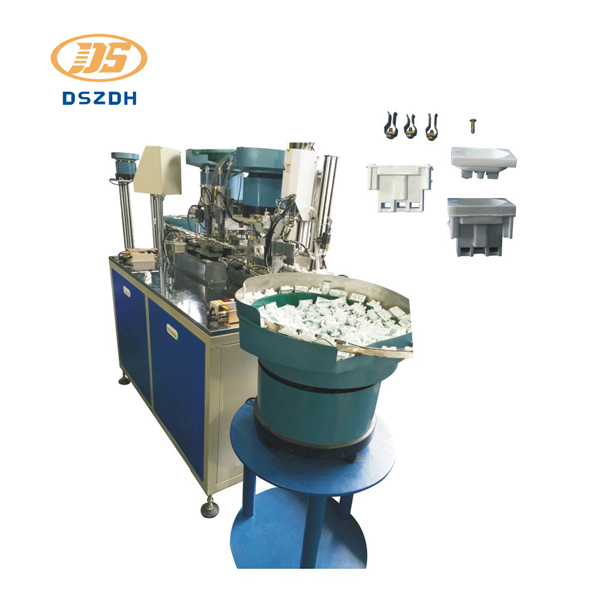How the Three Hole Socket Automatic Assembly Machine Streamlines Manufacturing Processes
2024-12-20
In the world of industrial manufacturing, automation plays a critical role in improving efficiency, reducing costs, and ensuring product quality. One machine that has become essential in the production of electrical components is the Three Hole Socket Automatic Assembly Machine. This advanced machinery simplifies and speeds up the assembly of three-hole sockets, which are commonly used in electrical wiring and connectors. In this blog, we will explore how this machine functions, the benefits it brings to manufacturers, and why it’s a must-have for modern assembly lines.
What is the Three Hole Socket Automatic Assembly Machine?
A Three Hole Socket Automatic Assembly Machine is an automated system specifically designed to assemble socket components that require the alignment and integration of three distinct holes. These machines are equipped with advanced robotics, precision tools, and control systems to ensure fast and accurate assembly. Whether the machine is used for electrical outlets, plugs, or similar components, it ensures that the assembly process is carried out seamlessly without manual intervention.
Given the importance of precision and speed in socket assembly, these machines are crucial for maintaining high production standards and meeting large-scale production needs. They are widely used in industries that manufacture electrical equipment, automotive components, and consumer electronics.
Key Benefits of the Three Hole Socket Automatic Assembly Machine
1. Faster Production Rates:
Automation is a game-changer for improving production rates. The Three Hole Socket Automatic Assembly Machine operates at significantly faster speeds than human operators, allowing manufacturers to produce large quantities of sockets in a short time. This is particularly advantageous for companies facing high demand and tight deadlines.
2. Enhanced Precision:
One of the most important factors in socket assembly is precision. Even slight misalignments can lead to faulty products. With an automatic assembly machine, you can rest assured that every socket is assembled with perfect alignment, reducing the risk of defects and improving overall quality.
3. Reduced Human Error:
Manual assembly, although effective, is prone to human error. Operators can become fatigued or distracted, leading to mistakes that compromise product quality. With automation, the Three Hole Socket Automatic Assembly Machine performs repetitive tasks with consistent precision, minimizing errors and reducing the need for rework.
4. Cost Savings:
Although the initial investment in automated machinery may be significant, the long-term cost savings are substantial. By reducing the need for manual labor, minimizing material wastage, and increasing production speed, these machines contribute to cost efficiency. Additionally, the consistent quality of output reduces the risk of returns or recalls, saving manufacturers money in the long run.
5. Improved Safety:
Assembly lines can be hazardous, especially when workers are dealing with heavy machinery or high-voltage components. The Three Hole Socket Automatic Assembly Machine eliminates many of these risks by taking over the dangerous or repetitive tasks, ensuring a safer working environment for operators.
6. Reduced Material Waste:
Automatic assembly machines are highly efficient in terms of material usage. With precise handling and accurate assembly, these machines help minimize material waste, ensuring that manufacturers get the most out of their raw materials.
How Does the Three Hole Socket Automatic Assembly Machine Work?
The operation of a Three Hole Socket Automatic Assembly Machine involves several key steps:
1. Component Feeding:
Raw materials such as socket bases, connectors, and other necessary components are fed into the machine via automated feeders or conveyor systems. The machine is designed to handle various components and deliver them to the correct positions for assembly.
2. Assembly Process:
Once the components are aligned, robotic arms or automated tools work to assemble the socket, securing each part into place with precision. These processes may include pressing, screwing, or snapping parts together, depending on the design.
3. Quality Control:
After assembly, the finished product undergoes quality checks, which may involve visual inspection, electrical testing, or dimensional verification. The machine’s built-in sensors and cameras can detect defects early, ensuring that only fully functional products make it to the next stage of production.
4. Packaging:
Once the socket assemblies pass the quality control checks, they are automatically ejected from the machine and prepared for packaging. This stage can also be automated, ensuring smooth transitions from production to distribution.
Applications of the Three Hole Socket Automatic Assembly Machine
- Electrical Industry: Used in the assembly of outlets, plugs, and electrical connectors, ensuring safe and efficient production of electrical components.
- Automotive Industry: Automating the assembly of automotive electrical systems, including connectors, wiring harnesses, and other socket components.
- Consumer Electronics: For manufacturers of devices that require secure and high-quality socket assemblies for powering up electronic devices.
The Three Hole Socket Automatic Assembly Machine is an invaluable tool for manufacturers looking to increase efficiency, reduce costs, and maintain high product quality in socket assembly. By automating the process, businesses can enjoy faster production times, reduced error rates, and improved consistency in their final products.



